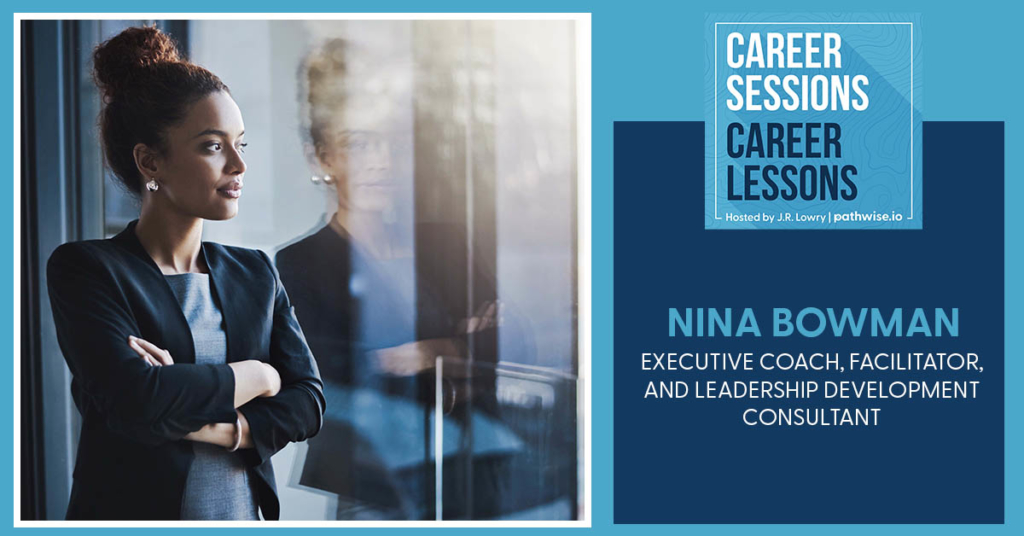
The Leader’s Mind, With Nina Bowman
What if we could get inside a leader’s mind? What would we see? Nina Bowman has come as close to doing this as possible. As an executive coach and leadership development consultant, she has developed a unique insight into how leaders think and how it influences their actions. In this conversation with J. R. Lowry, Nina shares her views around the biggest challenges that leaders face today, from personal development to building leadership teams that are able to drive impactful results. She also talks a bit about her journey in leadership development and the work that she currently does at Paravis Partners. Tune in and let Nina’s wisdom and experience guide you to the next level of your career.
Check out the full series of “Career Sessions, Career Lessons” podcasts here or visit pathwise.io/podcast. A full written transcript of this episode is also available at https://pathwise.io/podcasts/the-leaders-mind-with-nina-bowman.
—
Watch the episode here
Listen to the podcast here
The Leader’s Mind, With Nina Bowman
Executive Coach, Facilitator, And Leadership Development Consultant
In this episode, my guest is Nina Bowman. Nina is a Partner at Paravis Partners and is an executive coach, facilitator, and leadership development consultant. She has expertise in assessing and coaching senior-level leaders from across the globe and has trained and coached hundreds of leaders from a wide variety of sectors, including professional services, financial services, technology, private equity, healthcare, pharmaceuticals, consumer products, and education.
Prior to joining Paravis, Nina was a Principal and Founding Partner of Bowman Consulting, a career management services firm for senior executives. She was also a Client Partner with Korn Ferry, where she specialized in the recruitment and assessment of senior-level executives in the professional services and technology sectors.
Prior to joining Korn Ferry, Nina was a Strategy Consultant with Accenture and was a Senior Director of Corporate Strategy for a high-growth consultancy. She is the author of the LinkedIn course, Coaching Your Team to Think and Act Strategically, as well as a contributing author to the Harvard Business Review Guide to Coaching Employees and the HBR Guide to Thinking Strategically.
She is a public speaker and writer on various career management and leadership topics. Nina holds an MBA from Harvard Business School, an undergraduate degree in Economics from Brown University, and a leadership coaching certification from Georgetown University. She resides in the Boston area.
Nina, welcome, and thanks for making time for this. I appreciate it.
You are welcome, JR. Thanks for having me.
Let’s start with what you are doing now. You’re a Partner in a Executive Coaching and Leadership Development. Give our audience a sense of what your business entails.
Paravis Partners is my firm. It’s an executive coaching and leadership development firm. I co-own and manage it with two other business partners. We have a team of consulting partners and independent contractors that work with us to service our clients. Since we do executive coaching at the senior and C-level, we also do assessments and diagnostics to help those leaders get a better sense of where they are at the start of the process. We provide other tools as well. We do interviews in order to help them improve their self-awareness, but we also have a whole cadre of other assessment tools that can be used to deepen their self-awareness.
In terms of other services, we do a lot of work in team alignment and work with leadership teams to align everyone on the team, whether that be strategic alignment or aligning communication styles and managing team dynamics. That’s a lot of facilitation or team coaching work in order to get the team to work more effectively together. Other aspects of what we do are just speaking, talking at various executive events, or holding webinars for different organizations on some of the topics that we help leaders work through.
Are there particular industries that you tend to focus on?
We work across industries and are focused on the discipline of leadership development across any industry. Our firm does have a strong bench of folks that are in Boston and the DC, Maryland, and Virginia areas. A good deal of our work comes from those areas, but also across the country as well. In those areas, we tend to work in industries that are near us.
For me, that means life sciences. It means financial services and the many disciplines under that, whether it’s asset management firms or private equity companies. Down in DC is a whole cadre of professional services firms. We have deep experience in those areas, but there isn’t an industry we haven’t worked in at this point. We do focus on the discipline of leadership.
What are some of the most prevalent issues or topics that your clients come to you with and ask for help with?
There’s a range, but often it’s about scaling leadership. If we think about our careers and how we go from one organization to the next over the range of our careers, sometimes we get to a place where we realize that what we were doing before may not necessarily be working as well now or we are not adjusting for the context.
We are helping individuals scale their leadership for what they need to do now. That is a big thing. I would say alignment of stakeholders in order to get the results that the leader is working towards, whether that means working with their boards and aligning with the boards, aligning their leadership teams, or aligning the organization to mentor what it needs to transform into. We are supporting the leader through all of that.
We are building effective leadership teams and helping with the leadership presence and voice that’s needed. It is very context-specific in terms of how they might need to show up to do the job that they are doing and that helps them understand how their presence or voice might need to adjust for the task at hand. There are also aspects of just managing complexity. These are big jobs, and there’s a lot of complexity. We are helping them think about how we prioritize and cut through the noise a little bit to bring focus to what we are trying to do so that we can get to the impact faster.

Nina Bowman: We are building effective leadership teams and helping with the leadership presence and voice that’s needed.
You talked about doing assessments earlier. When your clients come to you, do they come with a fairly high degree of self-awareness, or is that a big need for them when they first become your clients?
As you might imagine, there’s a range. As we work with pretty senior leaders, they’ve gotten to where they are because they likely have some aspect and some element of self-awareness. Most good leaders recognize that it’s an ongoing process to deepen self-awareness. You have to do that work in an ongoing way.
Good leaders recognize that deepening self-awareness is an ongoing process. Share on XEven when we have someone who’s self-aware, it’s [about being] self-aware in what context and helping them think about how to continue to evolve [with]in that [context]. There are many ways in which we help them to deepen that. Sometimes it’s at the beginning of the engagement, while we are doing self-assessment work, and it’s certainly happening throughout an engagement.
I know you are certified personally in a number of these [assessment types]. What are the go-to assessments that you feel have the most research backing, credibility, or whatever way you want to describe it?
There are a few. I always like to do a qualitative assessment, which is an interview-based assessment. My preference is to start there because it’s just so much richer in terms of helping you to understand the individual but also understand all the players. I like to start by using a lot of qualitative assessments.
In addition to that, I’m a big fan of Hogan. Most of our clients are pretty senior and have a deep level of self-awareness coming in. That is a very deep assessment. It gets to our deepest motives and understanding of our behaviors in a way that maybe some other assessments don’t necessarily do, so that is always a go-to.
There’s lots of debate and controversy about Myers-Briggs. It can still be very helpful in just understanding some basic patterns. That is one that I like to engage in as well, at least when working with teams. There are some 360s that are quite deep. The Leadership Circle Profile is one of them. It’s one of those that takes you to a whole other level at understanding why you do what you do. Those are some of my go-to’s.
I still remember when I first encountered Myers-Briggs, which is the first of these that I took. It was like a revelation. Maybe imperfect but it was still a revelation.
There’s always another layer that we can uncover. I find even with clients who maybe have used one of those tools several years back that by bringing it current, they pick up something different because they are noticing the nuances in their current context and what these things might mean to where they are leading at present. It can be helpful to pull them back out or refresh them and look at them with new eyes. Also, folks grow from stage to stage and [based on] what the next level of growth looks like for them. Knowing your starting point is always going to be important.
Knowing your starting point is important in knowing what the next level of growth looks like for you. Share on XLet’s talk about some of the specific areas you mentioned earlier. We talked a little bit about this in our prep call. In terms of setting a vision, that’s a key role for a leader, to think strategically and articulate that vision. Where do your clients struggle with that, and why do you think that’s the case?
Most of the struggle in setting a vision is because there are just so many day-to-day demands that pull them from truly taking the time to think strategically. It is about helping them manage that delicate balance between their day-to-day needs and urgencies and always looking down the pike, and that’s the starting point. In some cases, there are more risks required, to do some of the things that we have to do, and [they need to] understand their comfort level with risk and how that intersects with the strategy that they are developing.
With the work that I do, there may be some strategic skills that they need to deepen. What’s most important is understanding themselves [in terms of] their risk tolerance and ability to cut out the noise. What are their habits and routines to do that? Do they have any routines where they are carving out time to think strategically?
It’s also important for them to realize that doing that work well is a whole-person exercise. Many times they are approaching it intellectually, but they are not going to do their best creative thinking if they don’t have great routines for how they are taking care of themselves or their bodies, what they are putting into their bodies, and whether they’re taking time to do mindfulness work. All of those things help them to be more creative and innovative thinkers. They have to think about the entire process and system, not just the intellectual work of figuring out the path forward.
Since you talked about the whole person, let’s go there next. What are the types of challenges? I imagine where they focus their time and how they balance work and life would come up. Are there other things around just how they bring their authentic self to work and what that means that you tend to get into on a fairly regular basis?
Bringing their authentic self to work means that they are not trying to lead in someone else’s fashion. That they are not leaving their thoughts, feelings, and emotions at the door when they come in. Most organizations need that, and most of their employees want that now. We saw through the pandemic that those who weren’t able to demonstrate compassion and empathy for what was going on and thinking about others demonstrated that those leaders struggled through the pandemic.

Nina Bowman: Bringing your authentic self to work means not trying to lead in someone else’s fashion, and not leaving your thoughts, feelings, and emotions at the door when you come in.
There are lessons in what it means to bring their full selves to work. Understand their feelings and how they deal with a crisis and what their reaction to the crisis is. There still needs to be a balance. Yes, you bring your emotions and your feelings, but you have to do it in the context of, “What do my folks need from me right now?” There has to be that balance that you can demonstrate the energy and feeling that’s needed, but comes within that broader question of, “What do my folks need to feel right now? What do they need from me right now, and how do I bring that?”
Do you think that particularly with what’s happened during and since the pandemic that we are past this point of expecting our leaders to be perfect and expecting them to be invincible, all-knowing, and all of that? Are people still, “I want to know who they are, but I also want to see some level of perfection in them?”
It has lessened the expectation of perfection, and the pandemic isn’t the only thing. I think about the technology shifts that have occurred. There’s a different pace that’s required in leading right now. That means that you can’t do it [like you did before]. Leaders have to first recognize that. Employees more and more recognize that, but there’s still tension there.
As I said, there’s still an aspect of needing something from our leaders. In times of crisis, we need them to bring a sense of calm. We may realize that it’s not a calm situation, but we are still needing that. We are still at this perhaps imperfect place of having a better understanding that our leaders can’t be all-knowing and so independent, but also having a feeling that we need a little bit of certainty in the uncertainty. As long as leaders understand that and use that knowledge, they can [accommodate] that dynamic tension. They can work with it.
In times of crisis, leaders need to bring a sense of calm. Share on XIt’s a lot harder. If you are a leader, it’s one thing to say, “I’ve got to come in and bring my A game every day and look the part, talk the part, or whatever.” It’s a lot harder to find a balance between doing enough of that that you are credible but also showing vulnerability and empathy. It feels a lot harder.
It is a lot harder. I will say that the leaders who try to go it alone often stumble. The job is simply just too big, and no one person can do it [alone]. That’s why we are seeing so much focus on leadership teams now and the demand and requests for the work to get leadership teams to work effectively to be high performing. Those are requests that are coming in more and more because the leader needs the full team to work and work well.

Leader’s Mind: Leaders who try to go it alone often stumble. The job is simply just too big, and no one person can do it.
It’s helping them understand one another in a deeper way and pulling on the strengths of each individual on that team to know how to use them at different points. That means the leader has to think about and understand where they lead from and what has their experience taught them about being comfortable letting others lead and reshaping their mindset about what’s required of them.
Many of them are coming from other organizations, and there may still be some old mindsets in there. The leader has to understand what’s the mindset that drives them and shapes how they are working with their team, and how they are working with their full organization, and be able to say, “Is that the mindset that’s needed right now? If it’s not, how do I shed that and do something different that’s going to allow me and my team to work in tandem and bring the full strength of the team to bear on our extremely complex problems right now and challenge it?”
You talk about team leaders got a lot of relationships to manage. If they are a CEO, they have got to manage relationships with the board. If they are anybody else, they have got to manage relationships with their boss, peers, their direct reports, and people in other parts of the company. How much of a factor are our relationship issues in the work that you do with your clients, and how do you help your clients work through that process of taking stock of relationships and figuring out where they need to do something different?
That work will keep my firm and other firms like mine busy for a long time. It is the work. The faster leaders appreciate, the faster they can move towards gaining alignment in their organizations that it is a process of understanding what each person, team, division, or every level is needed and the relationships at the heart of that.
We can only end and gain alignment if we show the other that we know who they are, we know what they need, we know what’s important to them, and we are able to find the intersection of that. It’s deep relationship work at every level. The more we clue into that and work on that, then the fast everything else happens.

Leader’s Mind: We can only gain alignment if we show the other that we know who they are, what they need, and what’s important to them. It’s deep relationship work at every level.
Influence is a key component of that. Another one of those revelatory moments was in one of the McKinsey training I did where we talked about twelve different kinds of influence, I naively up until that point thought the facts ought to carry now. The facts carry now for some people, but for a lot of other people, it’s very different. To your point, you have got to know what they need.
The work is understanding what motivates each person stakeholder and doing the work to understand that and being self-aware enough that what motivates them may not be the same thing that motivates us. If we enter the conversation and the dynamic with the assumption of what works for us works for everyone, we have to enter that conversation with a sense of empathy and an openness to the fact that our life trajectories have shaped each of us in lots of different ways, and we have to figure out what’s going to work for that person.
Do you go to the point of doing stakeholder analysis person by person?
Absolutely. Literally, we will take a look at a particular issue, or let’s just say I’m helping a person think through it like maybe they are shaping a new strategy for their organization. We are mapping out who are the major stakeholders and who needs to be influenced. We are having them do the work of reflecting on what’s important to that stakeholder and what will resonate with them.
We are helping them reshape the message to map to that particular stakeholder so that they are pulling the right messages and not just going with a blanket discussion or conversation. That’s a lot of work. It’s a lot of detailed work, but that’s the way we like to work. It’s, “Let’s take a problem that you are currently working on and work that live as you are going through it and build in a series of exercises and practices that help them along in what their day-to-day work is.” We get into the detail with our leaders.
That process of working through a live example makes it a lot more tangible. It’s rather than it being a conceptual exercise becomes much more about what you have got to wrestle with right now.
It’s a great opportunity to be able to uncover the things that might be blocking the leader. Let’s just say that they come in with the sense of, “Because I’m the most senior person, they should lean towards me,” and the answer is yes, in general. Your team should, but if you enter the conversation with that mindset, you are going to be missing an opportunity. They hear new ideas. They influence them in a way that’s positive. Again, they have to understand what’s the mindset that they are going into that conversation with and how might that mindset help or hinder which needed in getting buy-in on a particular strategy.
There’s a ton going on now particularly with labor markets being pretty tight still just around talent. What do you see the best leaders that you work with doing in terms of recruiting and developing talent in their organizations?
The thing about managing talent and best practices is that the talent strategy has to support and align the strategy. The best organizations aren’t doing those things separately. They are saying, “What is our strategy, and what’s the talent that’s needed? What are the skills that are needed? What are the behaviors that are needed to help us get there?” There’s realignment between those two strategies, and that’s the primary aspect of it.
They have regular routines for how they are understanding their talent. They are doing talent reviews. There’s a measurement along the way so that they know who their high potentials are. They are able to identify them. They map a strategy that goes from beginning to end, from when the person joins to the whole trajectory of their career in the organization that they are having in a way that is building and developing consciously.
They are also thinking about not just the individual but the team or the division. It’s a multi-layered approach to thinking about talent strategy. The best organizations are thinking about it in those ways. I would say that one of the most important things is that they are not outsourcing that to somebody else. The senior leaders are intimately involved in talent. They are mentoring and developing, and they know what is happening and are guiding it. That is a critical piece. If you think that you can fully outsource that, you might be in trouble at the end of the day because it needs you as a leader being involved in that process.
How does that affect the role of the leadership team versus the role of HR? A lot of people would read the answer you just gave and say, “That’s not like what the place I work in is like.” I have always wondered how that dynamic works and the best of companies around the dynamic between HR.
The role that HR plays varies in organizations, but in the best organizations that we see, HR is playing a much more strategic role in the development of strategy. They are guiding a lot of that. They are doing it in sync with the senior, the CEO, and the other members of the senior leadership team. You need that strong connection and not make the HR just the tactical player in this.
HR is involved in the strategy and HR is helping to define what that means from the standpoint of what we then do for our talent strategy, but it is in constant communication with the rest of the leadership teams. They are bringing in those individuals throughout the various things that they are doing. If it means a particular individual, they may be fostering one-on-one conversations with a particular executive and the CEO.
They are bringing the senior talent into any training sessions that they are doing so that folks are hearing about the strategy from those individuals directly. They are fostering conversations so that people are able to make a connection between what they are doing every day and what the strategy is. When that connection isn’t there, then you lose alignment in the organization. That’s when organizations get very splintered. CEOs and leadership teams think they are doing one thing, but the rest of the organization is doing something else. The message has to come from them with the HR team guiding, leading, and making sure that those connections are happening.
Decision-making is a big part of the leader’s role. What do you see in the leaders that you work with in terms of their conviction and how they find the right level of conviction to be able to make the big decisions and the tough decisions when that’s what’s required?
You mentioned how difficult of an environment it is now, and you are right. It is requiring senior leaders to make decisions with certainty when there isn’t certainty in a lot of ways. They have to get comfortable with that. That’s why I say understanding their risk tolerance underlies that. They have to understand their decision-making style. We all have some tendencies there. Some leaders might move into this paralysis of wanting more and more information because they need to feel that certainty. They have to be able to pause and say, “What is the decision-making style that I need now? How do I get comfortable with the fact that I’m not going to know everything, but it needs to be good enough?”
Those leaders that have more perfectionist tendencies struggle with that. If they are aware that they do that, then they can push themselves. As a coach, I can push them to say, “How do you think you are landing right now in terms of your decision-making style and what is required? What do you think you need to do to move that faster with the action that you can take? What’s the worst that could happen if you just move to this particular decision?” and helping them think through that so they can make decisions faster. The key aspect of leadership right now is decision-making and aligning that to the pace that’s needed.
You said earlier that leaders can’t go it alone. It was in a slightly different context. A big part of what you need to do as a leader is to make the organization not so dependent on you personally. How much do you find yourself working with clients on the management systems, the processes, the culture, and the things that make them more self-sustaining when less dependent on whatever brilliance or greatness they bring to the organization?
Those systems are critical, and it’s not unusual that we are helping them think through what’s their succession management processes, for example, and what they look like. How do they deepen those things? It is always about how you are being able to pull up folks, not just yourself but others so that their folks at every level.
The management processes are critical, and we can’t separate them. A lot of the work is how you make sure that the processes are integrated and have them think through what the strategy is, what integrated systems are needed to support that particular strategy, and if they have integrated those systems. We do sometimes go pretty deep in a particular area if we see that there is an alignment and help them think through the action that they can take to deepen the alignment that’s needed.
How common is it for you to get into non-work stuff in the course of coaching?
It’s very common. When you are coaching someone, you have to coach the full person. As much as we all like to think that we can compartmentalize our lives, it’s really hard to do that. If something isn’t working right at home, I can guarantee you, even if you think you are hiding it, you are bringing it in. At the senior level, that is actually critical.

Leader’s Mind: When you are coaching someone, you have to coach the full person. As much as we all like to think that we can compartmentalize our lives, it’s really hard to do that.
From the moment you are walking in the door or showing up on the screen, your body language tells all. You have to learn to have some ways in which you can acknowledge what’s happening and let go. If you think that you have got to have these completely separate lives, you can try, but it’s difficult. I don’t think it works very well. Our conversations often bleed into other areas. It’s also not unusual that while we are working on something work-related that the benefit of that leads into the home. We have been thanked by many wives, husbands, or partners for whatever they have worked on has helped them on the home front as well.
I’m sure that’s the case. What do you do to help your leaders get better at course correction? Nothing goes perfectly the first time.
It is helping them understand how well they recover. Again, what is this mindset that they might have around perfection and making mistakes? We shift that mindset from, “I made a mistake,” t,o” I just learned something. This is how I’m going to pivot next time.” We all come into coaching with some mindset that’s been shaped. You have got to look deep into the past and understand those things. I’m not shy about letting someone know if I think deeper work needs to happen with a therapist. I’m not a therapist, but it’s understanding the patterns that shape us around, “Do we think of something very personalized?” That’s not helpful as we need to be agile and pivot.
What are the things that have shaped that mindset? How do we acknowledge it and know it but then move on to some different mindset that’s going to help us be able to pivot faster, which is, “I’m the CEO, but I have got a team?” We make decisions as we make decisions that are informed by the team, so we all own this. It’s work that we all have to do, and the only mistake is making the same mistake again and not learning.
The only mistake is making the same mistake again and not learning. Share on XCome back to some of the here-and-now kinds of things that people are talking about. One of them is that you have got a lot of generations in the workplace, from Baby Boomers all the way to Gen Z. Are you hearing anything from your clients in terms of how they are managing across so many different generations with so many different viewpoints, perspectives, life views, and all of that?
It is impacting most organizations. We haven’t seen this breadth, and it’s extremely challenging. One of the things that they get stuck in is the challenges of, “What would we be doing if this were customers?” If it were customers, you would be understanding each segment of the customer population and figuring out who they are and what they need.
They’d be this deep work to understand each segment so that you can serve it better and figure out the alignment and say, “Bring that same mentality into the company.” Make sure that everyone is well-versed in each of those generations, but also be careful not to stereotype. Sometimes we can get into, “Gen Zers need this. I want career mobility faster,” and they want the organization to work in socially responsible ways.
There are some generalizations, but be careful. You got to understand the individual. We can get in trouble with some of those generalizations. We have to personalize our approaches more in the workplace. What would we be doing if we approach this like, “How do you get a team to work?” It’s a lot of the same work.
We have lots of different diversity on the team, like the diversity of thought and background. We need to have a common agreement on what our expectations are of one another. Those agreements can’t just lean toward one person’s view or one type. We have to do that same work in our organizations to say, “What are the expectations that we have from all so that even though we have got these different generations, we can work effectively together?”
Top organizations are intentionally putting different generations together so that they can learn from one another. There’s a lot of really good learning that happens by appreciating what the different generations can bring to bear. How do we harness that as opposed to just seeing it as a problem that we have to fix? It’s not a problem. It’s an asset if we learn how to manage it like a diversity management problem. We only get better at it if we understand that diversity and work to harness its power of it.
Top organizations are intentionally putting different generations together so that they can learn from one another. There's a lot of really good learning that happens by appreciating what the different generations can bring to bear. Share on XRemote work is another big topic. What kinds of conversations are you having with your clients about remote work, hybrid work, and getting people back in the office, and why it matters?
They are struggling. You see the generational issues play out here where those who grew up a certain way at a certain timeframe believe that you got to be in the office now. The pandemic loosened some of that up, but you still have folks who are like, “They have got to come back in,” and they are learning because the younger generation does want more flexibility, and not everybody’s coming back.
The reality of that is moving largely in organizations right now. Their understanding that hybrid is they just have to learn how to work in that way in an ongoing fashion, and it’s not easy. They have to make the organization an attractive place to want to come in. That’s going to look different than what it looked like before. The organizations that are doing the best job are testing and trying. They know they don’t have the answer, but they are piloting different things to see what sticks. It’s that mentality that’s going to help them along as they do this versus the folks just having to come in.
There are realities around it. We all know that as much as we say there will be fairness in a process, it can be difficult to be fair when you don’t see somebody and don’t interact with them regularly. There are valid concerns about who’s going to get promoted and who’s not. For organizations, the more they talk about this openly, the more they figure out, “There’s a reality around how that could happen. What are we going to do to prevent that? How are we going to bring new and different information into the discussion? How are we going to deepen our relationship virtually to make sure that we are bringing in some balance?” They have got to think that way. It can’t be what we did before because we already know that it’s not going to work.
This too is hard, the analogy to what we were talking about in terms of some ways it’s easier to be the invincible perfect leader. It was a lot easier to have a five-day office culture. You knew where everybody was going to be on any given day, at least for the most part. It’s a lot harder now when managing the different circumstances that people are wrestling with and some are probably more real than others. It’s hard. I don’t feel like I have got this one cracked in the organization I work in, and we have got people who came back in. We are doing it three days a week. We got people who are not in three days a week. It’s like this battle of wills.
It’s a battle of wills. There’s a lot of this where I say that they have to do the work of managing. Honestly, leaders got a little lazy at this. Before the pandemic, this involves getting to know your people. They are like, “What am I supposed to do?” You have got to look at who you are. Folks who are more extroverted struggle with all the virtual, but they may bring to the table a skill of reaching out that’s going to be needed by everyone.
Folks who have more introverted tendencies will have to challenge themselves around what’s going to work for them in terms of reaching out to their people. There isn’t going to be that connection in the hallway when they say, “What am I supposed to do?” Randomly be like, “That is what you are supposed to do.” You have got to reach out more and it has to be your responsibility to do that. Assess how you are deepening the relationship with each person.
When I’m working with leaders, I’m saying, “Let’s take a look at your team and tell me about them. What is going to work for them? Let’s map out how you are going to deepen the relationship with each person. What it needs to look like might be different based on that team leader and different personalities and what’s going to work for each person.” Having a strategy for what it means to deepen a relationship is going to be important.

Leader’s Mind: Having a strategy for what it means to deepen a relationship is very important for leaders.
There’s been a big theme in this whole conversation about just being deliberate, thoughtful, and detailed. I’m thinking about the people. In the time we have got left, I want to talk a little bit about your background. You started in consulting. You moved into executive search. Now you are doing executive coaching and leadership development. How did your journey unfold from your days at Harvard?
Most coaches would say that they fell into this work in some way. I think most of us. I know that I was not even aware way back when that this was even a thing that this was a field. I didn’t know anything about it, but it was informed by my years in strategy. I worked with senior leaders and enjoyed that work, but recognized that, at the end of the day, I could spend all this time helping shape a strategy, but if I didn’t have a person or leader who could drive that, none of it was going to matter. There was this sense of I needed greater meaning in what I was doing. I wanted to see a greater impact. To me, it was one leader at a time, making each person meet their potential.
It’s that challenge of how I take the work of strategy that I was doing for organizations and say, “What does that process look like if I’m working on an individual? What is their individual strategy?” That question became an interesting one for me. I went from working at a strategy consulting firm to being Head of the Strategy at an early-stage organization to being at an executive search firm, but that executive search firm had a leader assessment arm. I became interested in that work. I could see the importance of it, then later they added a coaching arm. I became much more interested in that work than I did in the search work. I hired a career coach at that point in time. I said, “I want to get there, but I’m not quite sure.”
Because I was in search, I knew how to do it, but I also knew that my daily work would take up a lot of time. I needed an accountability partner to be able to say, “You said you wanted to be here by a certain time. What have you done this week to be able to make that happen?” It was a very interesting discussion that although I had a lot of experience on the career coaching side and had my own business for a number of years, it’s doing that that I wanted someone who was going to be that accountability partner. That is what helped me make the shift. I began doing some work at our alma mater for some of the career sides and then got some very quick experience on the executive coaching side because I was working in executive leadership programs.
I was working with a lot of executives across the globe. That deepened my experience and knowledge of executive coaching and leadership development work very quickly. I had an opportunity to join up with my business partners. One of whom I had recruited back at my old strategy consulting firm. They had been doing this work for a few years. I was looking to pivot, and we started talking over a series of years around what I was doing and what they were doing.
There was a point where it just made sense for us doing forces, and that’s what we did. Years later, here we are. It has been a good ride. I’d never thought of myself as an entrepreneur, but it is. That’s what I am. It’s been a great fit. I had been in large companies and I always saw myself as this large company gal, being able to navigate the different areas and politics, but who knew? The boutique-size firm was a great fit. It allowed me to manage my family and give me the room to manage my full life while also doing something meaningful and important. It’s been a good fit.
Who are your biggest influences?
I tend not to zero in on any one person because in doing this coaching work, you see the imperfections of events. It’s more of, “This is what I like about this person.” As I think about my career, there was a leader at one of the early strategy firms that I worked at. I got lucky. My first meaningful experience with a leader was with a leader who had incredible self-awareness and empathy.
He took the time to connect. I was just coming out of business school. This leader, every few months, would tap in and want to know how I was doing personally. We had conversations about what I wanted in my life and what he could do to help me along in that. I saw this model of what good leadership looks like, and I saw that early on and it was so impactful to me. I got lucky in a lot of ways with this individual. His name was Bill. He is no longer with us, but he was one of the most amazing mentors and leaders in my life.
It’s especially great when you get them early in your life. It helps your trajectory and also gives you a reference point that a lot of people may never get.
That’s exactly right. When they don’t get that and then I see them later on, it is this spec of needing to challenge them. It can be done in a different way. What if we reframe what leadership could look like? What if we look at the dynamic tension that we can be both direct and empathetic, and that we don’t have to make this false choice of being one or the other what might that look like?
What do you do to recharge your battery?
I am self-proclaimed more introverted in style, so for me, it’s about being alone, going for walks, reading a book, and more connecting. I need both. I need to have my alone time. I’m developing a pretty deep practice in meditation and mindfulness. That’s important to me. I find how critical it is and helping my clients, and it helps me too.
I’m running a business and delivering work. All the stresses and strains that they are dealing with, I have got to deal with them too. I have to approach my work with a lot of the same disciplines. For me, recharging means scheduling my alone time, but it also more and more means scheduling my time to connect. As we all get older, we recognize how important all of those important friendships, connections, and family members are and that they aren’t going to just stay strong on their own. They need real work intending too.
I won’t admit to getting older, but it’s very true. Last question, if you were giving your younger self advice or giving anybody advice, what 2 or 3 things would you share that are most taken away from all of your work over the years with so many leaders that matter the most?
Doing the hard work of answering that question of what has meaning for us and what shapes purpose. At the end of the day, it is what we all have to answer. The earlier we can start digging into that, then we can be clearer about what’s the next right thing for us. When leaders don’t take the time to answer the question, what’s meaningful to me, then they make choices that aren’t a good fit for them. It’s a big stretch in how they have to work and lead. The closer they can align to what gives meaning, then it’s all easier. Doing the hard work sooner is what I recommend to everyone to make the whole process and journey a little bit easier.
It’s very good advice. Thanks for doing this, Nina. I appreciate it. We covered a lot of ground. I always go back and internalize it. There’s a lot here that I will be going back and doing that internalization.
Thanks for having me. It’s been a great conversation.
I appreciate it, and have a great day.
Take care.
—
It was great having Nina on the show to help us get inside the mind of leaders with whom she works to talk a little bit about her journey in development as well. If you are ready to take control of your career, visit PathWise.io. If you’d like more regular career insights, you can become a PathWise member. It’s free. You can also sign up on the website for the PathWise newsletter and follow us on LinkedIn, Twitter, and Facebook. Thanks. Have a great day.
Important Links
- Paravis Partners
- Coaching Your Team to Think and Act Strategically
- Harvard Business Review Guide to Coaching Employees
- HBR Guide to Thinking Strategically
- Leadership Circle Profile
- LinkedIn – PathWise
- Twitter – PathWise
- Facebook – PathWise
About Nina Bowman
